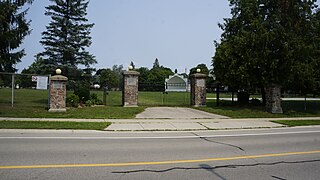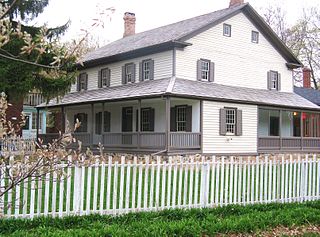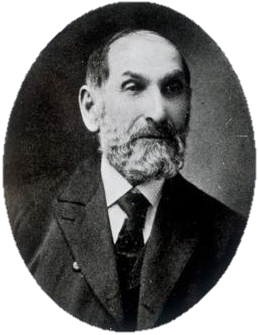
Waterloo is a city in the Canadian province of Ontario. It is one of three cities in the Regional Municipality of Waterloo. Waterloo is situated about 94 km (58 mi) west-southwest of Toronto, but it is not considered to be part of the Greater Toronto Area (GTA). Due to the close proximity of the city of Kitchener to Waterloo, the two together are often referred to as "Kitchener–Waterloo", "K-W", or "The Twin Cities".

Kitchener is a city in the Canadian province of Ontario, about 100 km (62 mi) west of Toronto. It is one of three cities that make up the Regional Municipality of Waterloo and is the regional seat. Kitchener was known as Berlin until a 1916 referendum changed its name. The city covers an area of 136.86 km2, and had a population of 256,885 at the time of the 2021 Canadian census.

Cambridge is a city in the Regional Municipality of Waterloo, Ontario, Canada, located at the confluence of the Grand and Speed rivers. The city had a population of 138,479 as of the 2021 census. Along with Kitchener and Waterloo, Cambridge is one of the three core cities of Canada's tenth-largest metropolitan area.

The Regional Municipality of Waterloo is a metropolitan area of Southern Ontario, Canada. It contains the cities of Cambridge, Kitchener and Waterloo, and the townships of North Dumfries, Wellesley, Wilmot and Woolwich. Kitchener, the largest city, is the seat of government.

Norfolk County is a rural single-tier municipality on the north shore of Lake Erie in Southwestern Ontario, Canada with a 2023 population of 73,015. Despite its name, it is no longer a county by definition, as all municipal services are handled by a single level of government. The largest community in Norfolk County is Simcoe, whose 2021 population was 16,121. The other population centres are Port Dover, Delhi, Waterford and Port Rowan, and there are many smaller communities. For several years in the late 20th century, the county was merged with Haldimand County but the merged entity was dissolved in 2000.

The Township of Wilmot is a rural township in the Regional Municipality of Waterloo in southwestern Ontario, Canada.

Waterloo County was a county in Canada West in the United Province of Canada from 1853 until 1867, then in the Canadian province of Ontario from 1867 until 1973. It was the direct predecessor of the Regional Municipality of Waterloo.
Galt is a community in Cambridge, Ontario, Canada, in the Regional Municipality of Waterloo, Ontario on the Grand River. Prior to 1973, it was an independent city, incorporated in 1915, but amalgamation with the village of Hespeler, the town of Preston and the village of Blair formed the new municipality of Cambridge. Being the largest constituent community in the city, it is commonly seen as the downtown core of Cambridge. The first mayor of Cambridge was Claudette Millar.

Preston is a community in Cambridge, Ontario, Canada in the Regional Municipality of Waterloo, Ontario. Prior to 1973 it was an independent town, incorporated in 1915, but amalgamation with the town of Hespeler, Ontario, the city of Galt, Ontario and the village of Blair formed the new municipality of Cambridge. Parts of the surrounding townships were also included. No population data is available for the former Preston since the Census reports cover only the full area of Cambridge, though the combined population of the census tracts covering the majority of Preston reported a population of 20,008 as of the 2016 Canada Census. The first mayor of Cambridge was Claudette Millar.

New Dundee is a small community of 1,119 people at the time of the 2016 Census, in the township of Wilmot, Ontario, Canada. It is located southwest of Kitchener.

Ayr is a community in Ontario, Canada that is located within the Township of North Dumfries in the Regional Municipality of Waterloo in Southwestern Ontario. Ayr is located south of Kitchener and west of Cambridge.
Joseph Emm Seagram was a Canadian distillery founder, politician, philanthropist, and major owner of thoroughbred racehorses.

Breslau (ˈbɹɛzɑː) is a community located within the township of Woolwich, part of the Waterloo Regional Municipality in Ontario Canada. Separated from the city of Kitchener by the Grand River, Breslau is named after the former German city of Breslau, now Wrocław, capital of Poland's Lower Silesia.

The Schneider Haus National Historic Site, formerly Joseph Schneider Haus, is a museum in Kitchener, Ontario, Canada. Situated on some of the earliest land to be settled by non-Indigenous peoples in what would become Waterloo County, the museum includes the oldest remaining dwelling in the area and was named a National Historic Site of Canada in 1999.

Jacob Yost Shantz was a Mennonite farmer, businessman, and industrialist from Ontario, Canada. He played a significant role in the urban development of Berlin, Ontario, where he held a succession of civic roles over a period of almost three decades, culminating in a term as mayor in 1882. Over the span of his life, Berlin was transformed from a rural agricultural settlement known as Ebytown into a bustling manufacturing centre; this was a change mirrored by Shantz, who began his adult life as a farmer and sawmiller, and ended it as a prominent local industrialist.

The Preston and Berlin Street Railway was an interurban electric street railway which served the 12.68 kilometres (7.88 mi) between what was then the towns of Preston and Berlin in Midwestern Ontario, Canada. The company was formed in 1894, but lay dormant until 1900, when construction finally began. The company began operation in 1904.
Bishop Benjamin Eby was a Canadian minister, schoolteacher, farmer, author, and community leader. He was a pioneer of the Mennonite community in Canada and a strong proponent of nonresistance.

Brubacher House is a historic house museum located in Waterloo, Ontario, Canada. It allows visitors to explore the everyday life of Pennsylvania German Mennonite settlers in Waterloo County from 1850 to 1890. The farmhouse is located on the traditional territory of the Attawandaron, Anishinaabeg, and Haudenosaunee Peoples.

The Erb-Kumpf House is a two-storey house located on 172 King Street South in Waterloo, Ontario, Canada. The oldest portion of the house was constructed circa 1812 by Abraham Erb, the founder of Waterloo, likely making it the oldest home or one of the oldest homes in the city. In 1979, the Erb-Kumpf House was designated as a heritage home under the Ontario Heritage Act by the City of Waterloo.






















